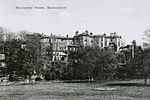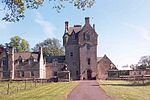Blackadder, Scottish Borders
Scottish Borders geography stubsVillages in the Scottish Borders
Blackadder is a hamlet on the B6460, in the Scottish Borders area of Scotland, located at grid reference NT846523. Places nearby include Allanton, Duns, Edrom, Fogo, Gavinton, and Whitsome.
Excerpt from the Wikipedia article Blackadder, Scottish Borders (License: CC BY-SA 3.0, Authors).Blackadder, Scottish Borders
B6460,
Geographical coordinates (GPS) Address Nearby Places Show on map
Geographical coordinates (GPS)
| Latitude | Longitude |
|---|---|
| N 55.7638 ° | E -2.24699 ° |
Address
B6460
TD11 3LU
Scotland, United Kingdom
Open on Google Maps








